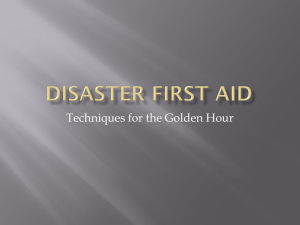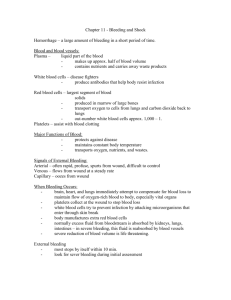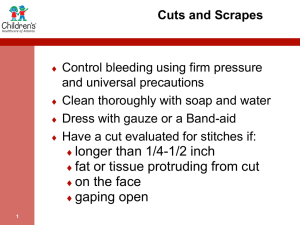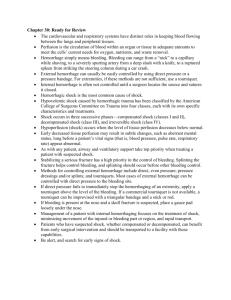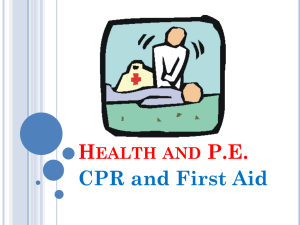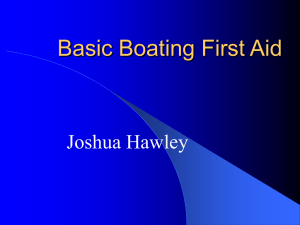FINAL EXAM STUDY GUIDE
advertisement
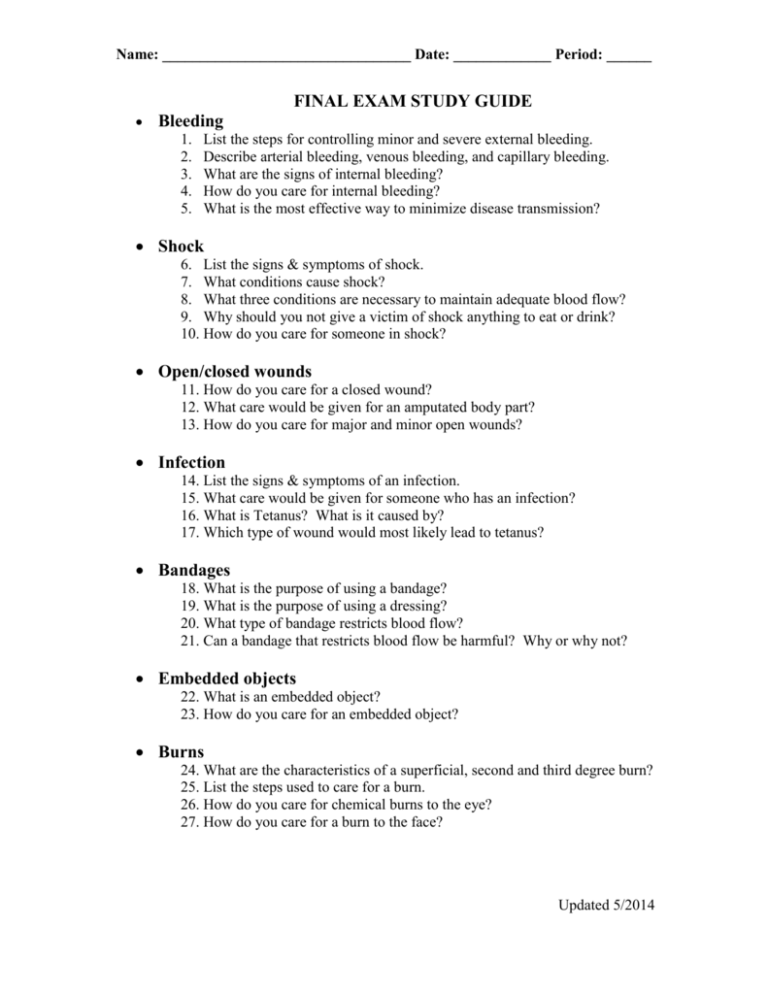
Name: _________________________________ Date: _____________ Period: ______ FINAL EXAM STUDY GUIDE Bleeding 1. 2. 3. 4. 5. List the steps for controlling minor and severe external bleeding. Describe arterial bleeding, venous bleeding, and capillary bleeding. What are the signs of internal bleeding? How do you care for internal bleeding? What is the most effective way to minimize disease transmission? Shock 6. List the signs & symptoms of shock. 7. What conditions cause shock? 8. What three conditions are necessary to maintain adequate blood flow? 9. Why should you not give a victim of shock anything to eat or drink? 10. How do you care for someone in shock? Open/closed wounds 11. How do you care for a closed wound? 12. What care would be given for an amputated body part? 13. How do you care for major and minor open wounds? Infection 14. List the signs & symptoms of an infection. 15. What care would be given for someone who has an infection? 16. What is Tetanus? What is it caused by? 17. Which type of wound would most likely lead to tetanus? Bandages 18. What is the purpose of using a bandage? 19. What is the purpose of using a dressing? 20. What type of bandage restricts blood flow? 21. Can a bandage that restricts blood flow be harmful? Why or why not? Embedded objects 22. What is an embedded object? 23. How do you care for an embedded object? Burns 24. What are the characteristics of a superficial, second and third degree burn? 25. List the steps used to care for a burn. 26. How do you care for chemical burns to the eye? 27. How do you care for a burn to the face? Updated 5/2014 Musculoskeletal Injuries 28. What is the difference between a ligament and tendon? 29. List the functions of the skeletal system? 30. Under what conditions would you call 911 for a serious musculoskeletal injury? 31. How do you care for a musculoskeletal injury? 32. What is an open fracture? What must you do before immobilizing the injury? 33. Define osteoporosis and tell me what population it’s most common with. 34. What is a joint? 35. What is the difference between a strain and a sprain? Do you care for them any differently? 36. When would you not want to elevate a broken limb? Splinting 37. List the four basic guidelines to follow when splinting. 38. Where would you place the bandages when splinting to make sure you have immobilized the area? Upper Extremity Injuries 39. How do you care for a shoulder injury? (6 steps) 40. How do you immobilize an upper arm injury? Lower Extremities 41. What are two characteristics of a broken femur? 42. How could a fractured femur cause someone to go into shock? 43. What is the best splint to use when immobilizing an ankle? .... knee? Head, Neck, Spinal Injuries 44. What are the signs of a serious head, neck, or spinal injury? 45. How do you perform manual stabilization? 46. In what situation would you not use manual stabilization? 47. How do you care for a cheek injury? 48. How do you treat scalp injuries with a possible skull fracture? 49. How do you remove a foreign body in the eye? Foreign object in the ear? 50. What causes a nosebleed and how do you care for it? 51. How do you care for a victim bleeding from the ear? 52. How do you care for a head, neck or spinal injury? 53. What is your primary concern when caring for a mouth or neck injury? 54. What is the best method used to save a tooth that has becomes dislodged? 55. What is a concussion? Updated 5/2014 Chest, Abdomen, Pelvis 56. What care is given for someone with a closed abdominal injury? 57. What are signals of severe chest injuries? 58. What are some signals of a rib fracture? 59. List the general care guidelines for chest, abdomen and pelvis injuries (in order). 60. Why could an injury to the liver be fatal? Sudden Illness 61. List the six general guidelines of caring for a victim of sudden illness. 62. What hormone is produced in the pancreas that diffuses sugar into cells? 63. What are risk factors for stroke and TIA? 64. How many times more likely does your risk increase for stroke, if you have high blood pressure? 65. What care would be given to a person who is having a seizure? 66. What care would be given to a person who just had a stroke? 67. List the signs and symptoms of a febrile seizure and who does it affect? 68. Under what conditions would you call 911 when someone has experienced a seizure? 69. Is there a difference when caring for a victim of hypo or hyperglycemia? Bites & Stings 70. Name three signs & symptoms you would see with a bite or sting. 71. How do you remove a tick? What care is given after removal? 72. What is the care for a jellyfish sting? a sea urchin? 73. What are the signs and symptoms of a snakebite? Heat & Cold Exposure Define and explain the care for the following: 74. Heat cramps 75. Heat Exhaustion 76. Heat Stroke 77. Frostbite 78. Hypothermia79. Why is it dangerous to re-warm a person with hypothermia too fast? 80. What is the proper dress for hot/cold weather? 81. How does the body react to cold temperatures? Updated 5/2014 Poisons 82. Define poisoning. 83. List the four factors that determine the severity of a poison. 84. Name four ways poison can enter the body and give examples. 85. How do you care for a person who has poison ivy? 86. What are the signs and symptoms of food poisoning? How long before food poisoning will occur after eating contaminated food? 87. How do you care for someone you suspect was poisoned? 88. List ways you can avoid accidental poisoning. 89. How do you care for someone you suspect has misused or abused substances? Reaching & Moving Victims Define the following terms: 90. Walking assist 91. Beach drag 92. Clothes drag 93. 2 person seat carry 94. Pack strap carry 95. Name a situation when you would use the assists listed above (#91-95). 96. What are the general guidelines for moving a victim without a head, neck, or back injury? 97. Which move or moves would you use for an unconscious victim? 98. What are the 2 methods for stabilizing the victim’s head, neck, and back in the water? Describe them. 99. What are some obstacles/limitations you could face when trying to move people quickly to safety? Updated 5/2014


